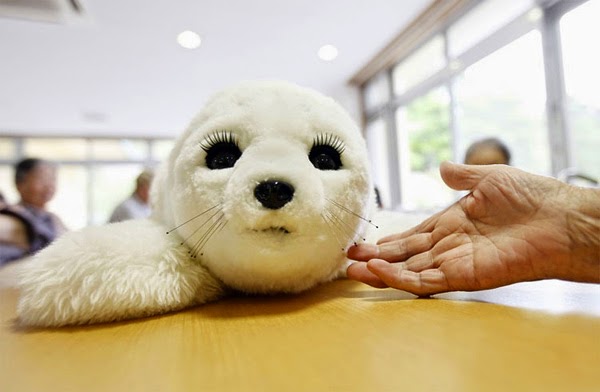The concept of interaction with animals used for therapy is a well- established one. We all are aware about therapy dogs who help and comfort many patients. Honestly we all agree getting a real dog is too much of a fuss, with all the care it needs. Now we have such a technology that we can create what we require, no matter what it may be, then why not a pet! Thanks to some new research, it does seem as though robots have something to offer the elderly, especially those suffering from dementia. In a pilot study published by the Journal of Gerontological Nursing, a team of Australian and German researchers allowed elderly patients stricken with dementia to interact with “therapeutic companion robots.” In this case, the researchers used a Japanese creation called Paro—robots designed to sense touch, light, sound, temperature, and posture. It was designed by Takanori Shibata of the Intelligent System Research Institute of Japan’s AIST.
PARO is an advanced interactive robot developed by AIST, a leading Japanese industrial automation pioneer. It allows the documented benefits of animal therapy to be administered to patients in environments such as hospitals and extended care facilities where live animals present treatment or logistical difficulties. PARO has been found to reduce patient stress and their caregivers. It stimulates interaction between patients and caregivers. In addition to it, it has been shown to have a Psychological effect on patients, improving their relaxation and motivation levels. PARO improves the socialiazation of patients with each other and with caregivers. It has been voted as the World’s Most Therapeutic Robot certified by Guinness World Records. Paro is the most interactive “healing pet” made to date, designed to be used for animal therapy without needing actual animals that require special attention. It learns from you, and feels just like a real, lovable pet in its natural responses. Paro has an array of sensors, and develops a personality over time that corresponds with how people play with Paro. It has taken artificial intelligence as we know it to a whole new level. It can recognize rhythm of morning, afternoon, and night. Encased with five kinds of sensors: tactile, light, audition, temperature, and posture it can perform many tasks like it can recognize light and dark, can feel being stroked and the amount of pressure, understands when it is being held and even recognize the direction of sound. Combined with the memory it has been provided with, it recognizes its name, greetings, and praise, remembers interactions and adapts, Imitates the voice of a real baby seal and Expresses feelings though noises, body movements, and facial expressions.
The use of companion robots and assistive technology in care for older people is in its infancy. Toyota, for example, is experimenting with assistive robots that can lift and carry patients to alleviate risks for carers. But they are not without controversy. Two concerns are that users are deceived, believing that the robot is real, and that it infantalises them, demeaning patients’ dignity.



